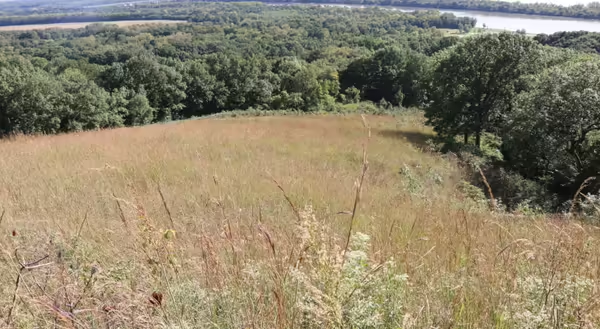
Illinois is the prairie state, but don’t think all prairies are the same. While deep-soil, tallgrass prairie dominated much of the landscape, other prairie types found niches too.
Along some of the big river systems in Illinois, hill prairies found a home perched at the top of steep, rocky bluffs. Hill prairies are sometimes called goat prairies because they are so steep only a goat could manage to visit them! They are usually found as little open pockets in a larger matrix of forests. Hill prairies most often occur at the top of bluffs with a south to west facing aspect. Most of the hill prairies in Illinois are along the Mississippi or lower Illinois Rivers.
Hill prairie have a unique assemblage of vegetation. Little bluestem and sideoats gramma were typically more dominant in these hill prairies, compared to the typical tall grasses like big bluestem and Indian grass. Hill prairies are also filled with a rich array of native forbs, including sunflowers, milkweeds, coneflowers, and even prickly pear cactus. Along their edges are native shrubs and trees adapted to the harsh environment. One rare tree, the Gum Bully, is a hill prairie specialist. Fire historically played an important part in the development of these systems and serves as the chief disturbance that keeps them in an open state.
Yet, even within this tiny subset of prairies, great variation exists. As you visit a hill prairie, often the upper portions sit atop loess soils. Loess is wind-blown silt that piled up on the top of the bluffs as the rivers carrying vast amounts of glacial runoff receded. This left great stretches of silt in the floodplains to dry and be caught up in prevailing winds from the west, with some loess deposited on the bluffs across the river. As you walk closer to the lower edge of the hill prairie, along the very edge of the bluff, this loess soil often diminishes leaving the bedrock below exposed. Here in this harsh environment, you find a suite of plants that are adapted to living in hot droughty conditions with almost no rooting space. One great example is the diminutive Whitlow grass, which is actually a tiny wildflower and not a grass at all!
While fire was a common occurrence in Illinois historically, it has largely been absent through suppression over the last 100-150 years. Native cedars, sumacs, and dogwoods along with invading shrubs like honeysuckle and autumn olive have taken advantage of the lack of fire on the landscape to close ranks on the hill prairies, robbing the prairie plants of much needed light. Now, many of our hill prairies are barely recognizable and a fraction of the size they once were. Interestingly enough, it is often the very lower edges of the hill prairie that have survived the best. The bluff tops are just too harsh for other plants to move in and take over.
The great news is work is underway in Illinois to revive and restore hill prairies. Fire is being brought back to them. Shrubs are being cut. The prairies are starting to stretch back out on top of the bluffs! Many of the hill prairies on private and public lands are protected through the Illinois Nature Preserve System, while others occur in state parks and other public lands. Check out one of our Illinois hill prairies. Not only are the plants and animals great, the views are spectacular! Great hill prairies with public access include Fults Hill Prairie, Revis Hill Prairie, Meredosia Hill Prairie and several at Pere Marquette State Park.
For more reading on hill prairies of Illinois, the Illinois Natural History Survey details 50 Years of Change in Illinois Hill Prairies. The 1955 Bulletin of the Illinois Natural History Survey by Robert Evers is a classic report on Hill Prairies of Illinois.
Want to get notified when new Naturalist News posts are available? SIGN UP HERE!
Chris Evans is an Extension Forestry and Research Specialist and the Interim State Coordinator for the Master Naturalist Program. He has been with the University for over five years. Chris has a BS in Wildlife Biology from Murray State University and a MS in Forest Biology from Iowa State University. He is interested in forest health and management, native plant restoration, and invasive species management.
Naturalist News is a blog by University of Illinois Extension Master Naturalist staff and volunteers who bring you stories highlighting the individuals, places, wildlife and plants that make this state amazing. Join us each week to learn something new, be inspired and become connected to your own community by recognizing the amazing ways we are all intertwined.